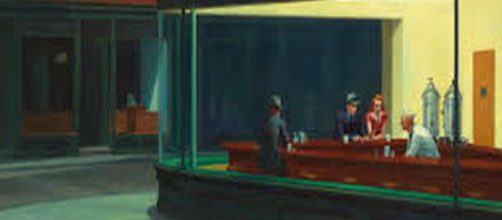The $300 million art collection of Barney Ebsworth, founder of luxury travel lines – nearly three dozen paintings by household names like Jackson Pollock, Willem de Kooning, and Edward Hopper - are set for auction on October 3 at Christie's NY. Marc Porter, chairman of Christie's Americas, told Bloomberg News, “This is the greatest collection of American modernism ever to come to market.”
An art story that doesn't make the headlines
While all three painters' names are art world stars, it's Hopper who should get extra attention because, while great wealth drives this auction, (Ebsworth founded luxury travel like the Royal Cruise Line and the Clipper Cruise Line), Hopper pointedly shunned affluence both in his life and work.
(More about his life in a moment). His paintings were usually portraits of alienation and loneliness in modern life.
You probably know his 1942 “Nighthawks,” which pictures people sitting at a diner counter without relating to one another. It sold the year it was painted for a paltry $3,000 to the Chicago Art Institute. It took 29 years afterward for a painting of his to reach a record sale: “East Wind over Weekhawken” painted in 1934, which shows a humble residential street in New Jersey with a modest house marked for sale in the years when economic woes forced people to lose their homes. It reaped $40.5 million; but he never knew it, having died in 1967. And while the sale price was his highest, it doesn't come close to the sale prices for De Kooning - $300 million in 2015 and $200 million for Pollock in the same year.
A scene of disquieting silence
On the auction block this time, is Hopper's 1929 painting “Chop Suey,” with an asking price of $70 million. The image shows diners in a banal-looking Chinese restaurant – two women at their table and a man and woman at a nearby table – without a focus on any of them. Despite the presence of people, there's a blankness to their faces and little sense of interaction.
A garish neon sign outside the eatery window lends a harsh and joyless air to the scene.
Shades of the starving artist syndrome
That sense of joylessness also marked the painter's life as revealed in the 1981 biography by art historian Gail Levin titled “Edward Hopper: The Art and the Artist.” In her account, he lived a hermetic life in rudimentary comfort, and his wife Josephine Nivison, also a painter, encouraged his thrift, shopping for most of their clothes at Woolworth's and at Sears.
She also hooked rugs from rags that she collected and cooked their dinners out of cans.
They both knew years of financial struggle as painters and apparently never forgot it. Never yielding to the whims of of fashion, Levin said the Hoppers always bought used cars and drove each until it would run no more. They also wore their clothes down to the threads. So, with all the ballyhooing about this $300 million auction, I can't help thinking of Hopper's disquieting work and wonder if it's the stark realism of his work rather than the abstract self-expressions of Pollock's and De Kooning's that speak most of life in modern America. .


